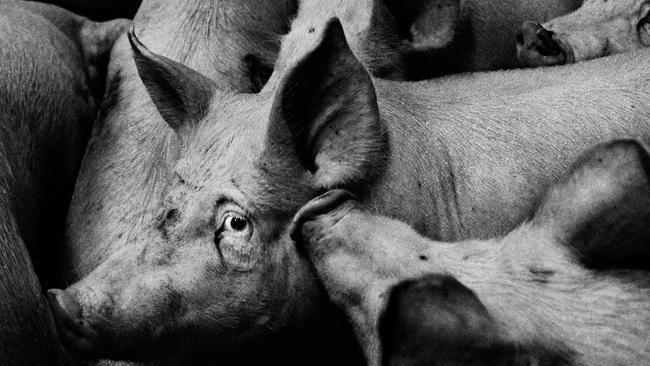Meat: the rite to kill
An extraordinary French novel considers the animal without and within.

There are few passages in contemporary literature where the gavel is brought down harder on humankind than those in JM Coetzee’s metafictional novel of 1999, The Lives of Animals. The hammer in that instance is wielded by writer Elizabeth Costello, herself a fabrication of Coetzee’s imagination, during a lecture given at an American college. Her words concern the treatment of animals in the era of industrial agriculture.
‘‘Let me say it openly,’’ she begins.
We are surrounded by an enterprise of degradation, cruelty, and killing which rivals anything that the Third Reich was capable of, indeed dwarfs it, in that ours is an enterprise without end, self-regenerating, bringing (livestock) ceaselessly into the world for the purpose of killing them.
Costello is a writer of some renown, though in the autumn of her career when these words are spoken. She has little to lose and that freedom is deployed bracingly here. But the initial shock of the comparison gives way to disturbing thoughts on the part of readers. Could it really be that the Holocaust never ended, that it merely migrated and found other categories of ‘‘subhumans’’ to destroy (for what could be more subhuman than an animal)?
At heart, what Costello suggests is that our conduct towards animals is not just a minor aberration in an otherwise benign modern age: it is the specific and inevitable expression of that technological nihilism and species chauvinism characteristic of our time. The same old Enlightenment hierarchies that congratulate our kind for its exceptionalism, she suggests, permit and justify our new collective violence.
Animalia, the fourth novel of French author Jean Baptiste Del Amo (though his first to be published in English, winner of both the Prix du Livre and Prix Valery-Larbaud in 2017), takes Coetzee’s disguised polemic and reimagines it as a proletarian epic, one that explores the relationship between human realm and animal kingdom through a century in the lives of a single peasant family.

Del Amo’s vocabulary is that of a pedantic veterinarian; his eye, that of a rhapsodic poet-naturalist. Combining these two registers permits him a democratic attentiveness. The sordid necessities of human and animal existence can sound exquisite when described by him, while conventionally pleasant rustic tropes can be rendered gruesome by dint of scientific exactitude.
Likewise, the author’s intellectual clarity provides a rigid scaffolding upon which women and men hang base instinct and traumatic inheritance, only dimly aware of the forces that have formed and continue to form them.
Wittingly or not, Del Amo takes the paradox of Elizabeth Costello’s words — that our refusal to acknowledge our imbrication in the broader animal world is the source of our most bestial acts — and makes of them a drama of futility and despair. His novel describes nothing less than an act of mutually assured destruction fought by humans against those creatures who sustain us.
Yet is can also glimmer with loveliness. Its pages contain rumours of another relationship to animals and the natural world, most accessible to children or the insane, which gesture towards an older, more balanced connection.
Take the modest feast, described in the opening chapters, which follows the killing of a pig in the fictitious Gascony village of Puy-Larroque: a celebration that has apparently survived from time immemorial, right up until the early years of the 20th century:
The enucleated pig’s head is boiled and then picked clean of every morsel of meat to make pate. The trotters are also boiled with herbs and spices. The ham hocks are salted and hung from the rafters to dry. The melted fat is decanted into jars. The children nibble on little pieces of fried pork rind that crunch between their teeth. Their hands and faces are glossy with lard.
‘‘A few hours later,’’ the passage concludes, ‘‘they gorge themselves on hot blood sausage and offal simmered in a sauce of wine and blood …’’ In a novel set so much in the trenches of human-animal relations, these lines constitute a rare armistice: epicurean yet frugal, industrious yet hedonistic, the feast suggests the old possibility of a communal, celebratory ritual of meat-eating, combining ritual and need, appetite and gratitude.
The family whose pig provides sustenance in this instance are not living in bucolic splendour, however, like extras from the film version of a Marcel Pagnol novel. Del Amo’s peasant family have dwelled, seemingly forever, in their rural remoteness. His depiction of their daily lives is ground-level, brutish, forged by the exigencies of poverty and ignorance.
Their days are filled with constant work, their hair and nails impregnated with dirt and ordure, their universe bounded by Catholic rite on one hand and the more pagan rhythms of nature on the other.
The matriarch of this family is known only as ‘‘the genetrix’’, as though procreation were her sole justification for existence. Out of mental illness, or spite towards a husband she despises, or simply a ruthless sense of self-preservation, she has twice avoided the trap of bearing children by surreptitiously feeding her newborns to the family sow.
A pair of primal sins, then, interrupted only by the birth of a third child whom the genetrix reluctantly permits to live.
That daughter, Eleonore, goes some way to making up for her mother’s awfulness. She grows up into a plain, tough, hardworking child, engrossed by the natural world, watchful towards the cruel genetrix but adoring when it comes to her hardworking and taciturn father, a man who slowly dies of lung disease throughout her early years.
A cousin named Marcel, brought in to help on the farm by the dying man, proves to be even more conscientious, driven by a desire to bring forth plenty from their small patch of rented land. Inevitably, Eleonore falls in love with him, an attachment that grows into a fierce passion when he is, with most of the men in the village, called up to fight on the Western Front and is reportedly killed.
Marcel doesn’t die — that is the final and most hurtful of the genetrix’s lies to her family — but returns towards the conflict’s end with terrible wounds and a ruined jaw. Faced with the twinned determination and vigour of the young couple reunited, the genetrix loses her mind and will to live, eventually dying in a way that quite literally poisons the pair. When they discover the old widow’s life savings amount to enough to purchase the farm, it seems, just for a moment, the disasters of the era are finally past.
The moment doesn’t last. Marcel has been changed by the war. He works just as hard but now there is an edge to him. When the couple have a child, a boy — Henri — Eleonore is obliged to protect the infant from the father when he drinks, which is more and more often as memories of the Great War’s horrors leach into his bones. It is a situation so awful that it comes as a relief when the narrative abruptly shunts forward to the early 1980s, a period when the family’s small farm has morphed into a large-scale factory feedlot for pigs.
By now, the reader, accustomed to the ineluctable misery Del Amo visits on his inventions, will know the drill. The industrialised slaughter of modern war has been made manifest in the agricultural practices adopted by the family. The feasts of old have given way to freezers bulging with pre-packaged pork, grimly ingested by younger generations of the family.
The honest dirt and shit of the fields have given way to a toxic cesspit whose fumes are as dangerous as the mustard gas faced by Marcel all those years before:
They have modified pigs according to their whim, manufactured unhealthy animals that maximise growth and produce monstrous carcasses that are all muscle and almost all fat. They have created hulking beasts that are also sickly, animals that have no life beyond the hundred and eighty-two days spent vegetating in the half-light of a pig unit, with heart and lungs that beat and oxygenate the blood only to constantly produce more lean meat for consumption.
It is to the French author’s credit that none of these connections are drawn with too straight a line. He allows them to emerge, rather, from the generational recurrence of madness, alcoholism and bloody-minded industry that stubbornly recur in the children and grandchildren of these wounded antecedents. They come out of the sense that some earlier and more morally acceptable species compact has been shattered by the demands of consumers who have lost all contact with what it is that they consume.
Meanwhile, the suffering embedded in each fresh iteration of the family are visited, in their turn, on the animals in their care. There is something monstrous — Frankensteinian — about this turn. No one is guilty because this sin of cruelty is inherited, externally imposed.
Yet no one is let off the hook because that same sin is endogamous, the bitter result of a family (and by extension, an entire species) so involute that it has grown hostile to the natural world, to a greater and more terrible knowledge than it can bear, and finally to the kinds of self-awareness that might reveal a way out of the trap.
Del Amo concludes his extraordinary work with a hunt for an escaped boar known as ‘‘The Beast’’, a creature unnaturally huge and aggressive, the awful final result of decades of selective breeding by the family, in which the bestial and the humanly sentient seem to swap over entirely.
It is not that there is no longer a difference between pig and man — the conclusion to George Orwell’s Animal Farm — rather, humans have lost themselves so deeply in the destructive forces of modernity that only the beasts they despise retain aspects of what it is to be human.
Animalia concludes as a novel in which the telescope has been turned and trained back on the observing reader. Back in the pages of The Lives of Animals, Elizabeth Costello, that redoubtable and constitutionally bloody-minded Australian writer, makes a further observation:
There are people who have the capacity to imagine themselves as someone else, there are people who have no such capacity (when the lack is extreme, we call them psychopaths), and there are people who have the capacity but choose not to exercise it.
Del Amo’s novel takes those of us who tremble between the first and third category and elegantly — ruthlessly — demands we enter into a renewed imaginative and empathetic contract with the animal world.
His is not an easy book to encounter. The request he makes may seem too daunting to most. But for those willing to enter the charnel house of our hallowed, model modernity and stay there for a while, standing witness to the seemingly eternal suffering of our animal cousins, the question of our current enlightened standing seems less assured.
This is not to suggest the novel should inspire some militant stance on the part of an engaged reader. It is likely that Del Amo regards veganism, say, as a final refinement of our abstraction from true connection with the animal kingdom, rather than a necessary response to the cruelty of our agricultural practices.
What it does do is ask us to remember what John Berger, another wise laureate of French peasant life, had to say about the ties that bind us to a broader world:
What distinguished man from animals was the human capacity for symbolic thought, the capacity which was inseparable from the development of language in which words were not mere signals, but signifiers of something other than themselves. Yet the first symbols were animals. What distinguished men from animals was born of their relationship with them.
Geordie Williamson is The Australian’s chief literary critic.
-
Animalia
By Jean-Baptiste Del Amo. Translated by Frank Wynne. Text, 424pp, $32.99




To join the conversation, please log in. Don't have an account? Register
Join the conversation, you are commenting as Logout